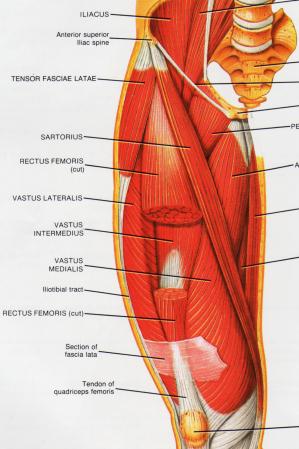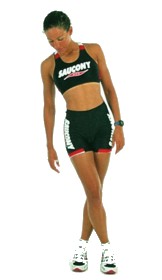|
Knee Pain, Knee Injuries and Iliotibial Band Syndrome
A Guide to the Treatment and Prevention of Knee Injuries and Iliotibial Band Syndrome!Knee pain and knee injuries, as a result of Iliotibial Band Syndrome, can be an extremely painful and frustrating injury that puts a big strain on both the knee and hip joints. Knee injuries are very common among runners and cyclists. However, they don't usually occur in an instant, like a hamstring strain or groin pull, but commonly starts off as a twinge or niggle, and progress quickly to a debilitating sports injury that can sideline the best of us for weeks. For those who aren't familiar with Iliotibial Band Syndrome, let's start by having a look at the muscle responsible for the problem. The iliotibial band is actually a thick tendon-like portion of another muscle called the tensor fasciae latae. This band passes down the outside of the thigh and inserts just below the knee.

The diagram to the right shows the anterior (front) view of the right thigh muscles. If you look towards the top left of the diagram, you'll see the tensor fasciae latae muscle. Follow the tendon of this muscle down and you'll see that it runs all the way to the knee. This thick band of tendon is the iliotibial band. Or iliotibial tract, as it is labelled in the diagram. The main problem occurs when the tensor fasciae latae muscle and iliotibial band become tight. This causes the tendon to pull the knee joint out of alignment and rub against the outside of the knee, which results in inflammation and pain. There are two main causes of knee pain associated with iliotibial band syndrome. The first is "overload" and the second is "biomechanical errors." Overload is common with sports that require a lot of running or weight bearing activity. This is why ITB is commonly a runner's injury. When the tensor fasciae latae muscle and iliotibial band become fatigued and overloaded, they lose their ability to adequately stabilize the entire leg. This in-turn places stress on the knee joint, which results in pain and damage to the structures that make up the knee joint. Overload on the ITB can be caused by a number of things. They include: • Exercising on hard surfaces, like concrete; • Leg length differences; Firstly, be sure to remove the cause of the problem. Whether is be an overload problem, or a biomechanical problem, make sure steps are taken to remove the cause. The basic treatment for knee pain that results from ITB Syndrome is no different to most other soft tissue injuries. Immediately following the onset of any knee pain, the R.I.C.E.R. regime should be applied. This involves Rest, Ice, Compression, Elevation, and Referral to an appropriate professional for an accurate diagnosis. It is critical that the R.I.C.E.R. regime be implemented for at least the first 48 to 72 hours. Doing this will give you the best possible chance of a complete and full recovery. Although the pain may be felt mainly in the knee, the problem is actually caused by the muscles that support the knee. Namely the tensor fasciae latae and the large muscle at the rear of your upper leg, called the gluteus maximus. Other muscles in the lower back, hip, backside and upper leg also affect the function of the knee, so it's important to pay attention to all these muscles. After the first 48 to 72 hours, consider a good deep tissue massage. It may be just what you need to help loosen up those tight muscles. Firstly, don't forget a thorough and correct warm up will help to prepare the muscles and tendons for any activity to come. Without a proper warm up the muscles and tendons will be tight and stiff. There will be limited blood flow to the leg muscles, which will result in a lack of oxygen and nutrients for those muscles. Before any activity be sure to thoroughly warm up all the muscles and tendons that will be used during your sport or activity. Secondly, flexible muscles are extremely important in the prevention of most leg injuries. When muscles and tendons are flexible and supple, they are able to move and perform without being over stretched. If however, your muscles and tendons are tight and stiff, it is quite easy for those muscles and tendons to be pushed beyond their natural range of movement.
Stand upright and cross one foot behind the other. Then lean towards the foot that is behind the other. Hold this stretch for about 15 to 20 seconds, and then repeat it 3 to 4 times on each leg. To keep your muscles and tendons flexible and supple, it is important to undertake a structured stretching routine. For a comprehensive reference of over 100 clear photographs of every possible sports related stretch, you can't go past The Stretching Handbook. If you're interested in stretches for the upper legs, hips and backside, The Stretching Handbook has detailed photographs of 36 different stretches you can do. Order your copy now!
And thirdly, strengthening and conditioning the muscles around your knee and upper leg will help greatly to reduce the chance of knee injury and knee pain. If you are in too much pain to resume normal exercise, consider swimming, deep water exercise, or maybe cycling. ------------------------------------------------------------------
|




 The stretch to the left is one of the best stretches for the tensor fasciae latae.
The stretch to the left is one of the best stretches for the tensor fasciae latae.